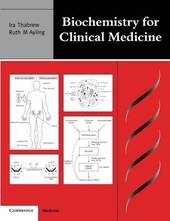
|
Biochemistry for Clinical Medicine
Paperback / softback
Main Details
| Title |
Biochemistry for Clinical Medicine
|
| Authors and Contributors |
By (author) Ira Thabrew
|
|
By (author) Ruth M. Ayling
|
|
Contributions by Claire Wicks
|
| Physical Properties |
| Format:Paperback / softback | | Pages:306 | | Dimensions(mm): Height 246,Width 189 |
|
| Category/Genre | Biochemistry |
|---|
| ISBN/Barcode |
9781900151085
|
| Classifications | Dewey:612.015 |
|---|
| Audience | | Tertiary Education (US: College) | | Professional & Vocational | |
|---|
| Illustrations |
100 Line drawings, unspecified
|
|
Publishing Details |
| Publisher |
Cambridge University Press
|
| Imprint |
Greenwich Medical Media Ltd
|
| Publication Date |
1 January 2001 |
| Publication Country |
United Kingdom
|
Description
Developments in biochemistry have contributed immensely to the rate at which medical knowledge has expended in recent years. Following the GMC recommendations regarding undergraduate medical education, Biochemistry for Clinical Medicine integrates, in a single volume, all aspects of biochemistry required by a medical student, with a special focus on information specific to medicine as opposed to laboratory-based biochemistry. The first section of the book provides an understanding of basic cell biology and the critical concepts of membrane transport, cellular energetics, information storage, transmission and expression, as well as describing the essential chemistry and metabolism of cellular biomolecules and the clinical conditions that arise from disturbances in their metabolism. The second section adopts a systems-based approach to present clinical biochemistry in an easily readable and concise manner, using tables and clear diagrams to summarise important facts, as well as providing information on the biochemical basis of good nutrition.
ReviewsIra Thabrew is Professor and Head in the Department of Biochemistry and Clinical Chemistry at the Faculty of Medicine, University of Kelaniya, and Ruth Ayling is a Consultant Chemical Pathologist at King's College Hospital in London. Both have long and extensive experience in research as well as in the teaching of medical undergraduates and postgraduates. They have come together to write a readable volume that focuses on the essential core of biochemistry that medical students must have to understand most aspects of clinical medicine, particularly pathophysiology, clinical chemistry and pharmacology. The authors have set themselves a difficult task, for it is all too easy to fall into the trap of trying to achieve simplification for its own sake bereft of accuracy and depth. And "clinical relevance" is such a subjective thing that no two readers are likely to agree on what should come in and what should be left out in a book such as this one. To complicate matters even more, medical studies (and doctors) are such a heterogenous group when it comes to their interest and willingness to grapple with biochemistry, even of the simplified sort. The chapters of the books are arranged in two sections. The first comprises 11 chapters dealing with cell biology, including cellular energetics, membrane transport, information storage and transfer, transmission, expression, and the more familiar areas such as carbohydrate, lipid and protein metabolism. These are followed by two chapters devoted to sodium and water metabolism and hydrogen ion homeostasis (what a relief to read this accurate title, after hearing and reading so often the inane expression "acid-base balance", so beloved of medical doctors!). These two chapters seem to achieve a seamless transition into the next 12 that introduce the reader to basic knowledge in clinical biochemistry. What do I like about this book? I like the untrammelled simplicity, clarity and directness of its writing most of all. Alth.
|